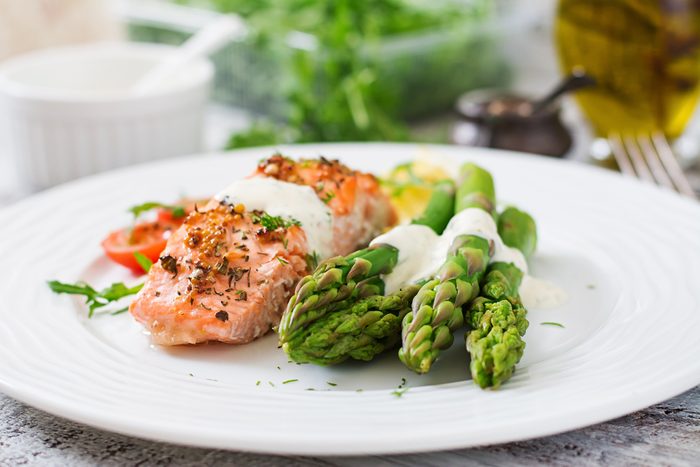
1. Salmon
Includes fresh and canned chinook, king, chum, coho, pink and sockeye.
How it Tastes: This fish has a pleasant, distinct aroma and meaty pink flesh.
Nutritional Info: All types of salmon are high in omega-3s, ranging from about 750 mg to 1,270 mg per 75-gram serving. They are also a good source of vitamin D, with one serving providing 100 percent of the recommended dietary allowance (RDA)-and the bones in canned salmon provide calcium. Because contaminant risk is low, there is no limit on consumption.
Is It Eco-Friendly? All wild Pacific salmon species face conservation issues. Farmed Pacific salmon is high in omega-3, but amounts may be lower than wild.
How to Serve It: To add a little drama to dinner, try salmon en papillote (cooked in parchment, which is readily available in grocery stores). “It’s really simple,” says Calder. “Finely julienne a carrot, leek and zucchini; sauté quickly till not quite cooked; and make a bed of the vegetables on the parchment paper. Sprinkle with a little fennel seed, and place the fish fillet or steak on top. Then fold the parchment over to create a small package. Bake in the oven at 375°F for about 10 minutes. It steams in the paper and you have a whole meal in there.” Calder also likes to dip a salmon fillet or steak in egg white, roll it in poppy seeds and pan-fry it.
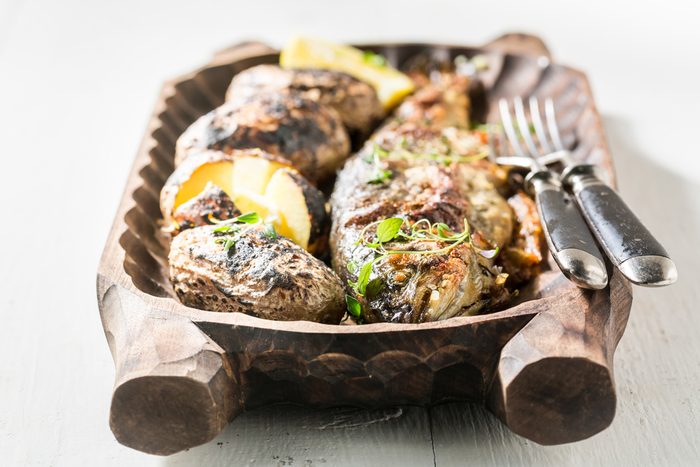
2. Farmed rainbow trout
How it Tastes: The pale pink, delicate flesh has a nutty flavour that’s milder than salmon.
Nutritional Info: With 866 mg of omega-3 fatty acids per 75-gram serving, rainbow trout offers more than a day’s recommended intake. In addition, it provides plenty of vitamin B12, which may help reduce the risk of heart disease, says Dombrow. Because rainbow trout is low in mercury, there is no limit on consumption.
Is It Eco-Friendly? Most rainbow trout found in Canadian stores are farmed in ponds or raceways (channels), says Shauna MacKinnon, market campaign coordinator for the Living Oceans Society, a non-profit conservation group. “Because they are contained, escapes into the wild are rare,” she says, so there’s little risk to local stocks. If you’re buying in Ontario, ask whether the trout was farmed in open-net cages in the Great Lakes; this practice can pollute the water.
How to Serve It: “In central France, you typically see a whole trout wrapped with bacon,” says Calder. Create the same effect by wrapping a whole trout or fillets with just a few pieces of bacon, excess fat trimmed off. Place the fish on top of several lemon slices and bay leaves, drizzle with olive oil and bake at 400°F (for a one-inch [2.5-cm]-thick fillet, about 10 minutes, or until flaky). For a quick sauce for baked or grilled fish, Calder suggests combining drained capers, lemon zest and olive oil with some fresh parsley, basil or mint.
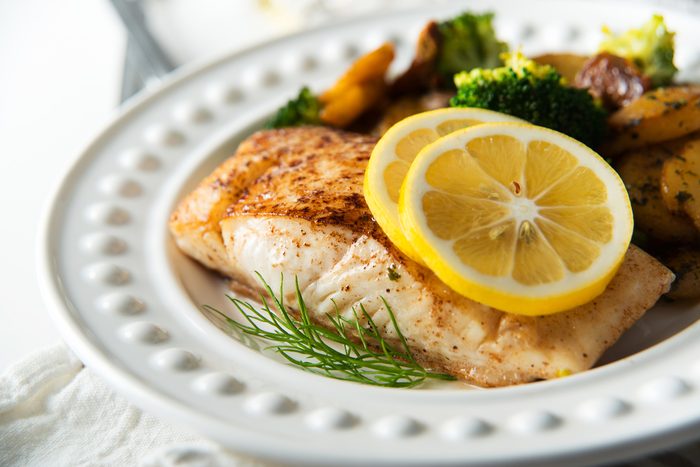
3. Pacific halibut
How it Tastes: This firm white fish has a mild flavour that appeals to even fussy fish eaters, and it is highly versatile.
Nutritional Info: Halibut contains close to an entire day’s worth of omega-3s (439 mg per 75-gram serving). “It’s also low in overall fat with only two grams of total fat per serving, and it’s a good source of potassium and vitamin D,” says Dombrow. (To be cautious, women who may become pregnant, or are pregnant or breastfeeding should eat halibut only once a week, to avoid exposure to relatively high levels of mercury.)
Is It Eco-Friendly? Pacific halibut currently has a green light from American conservation groups, although one concern, says MacKinnon, “is that juvenile halibut are discarded or thrown back, reducing their chance of survival.” Avoid Atlantic halibut, which is vulnerable to overfishing.
How to Serve It: “You can do so much with this fish,” says Calder. She likes to steam halibut steaks or fillets wrapped in Boston lettuce leaves (use a bamboo steamer or a double boiler with holes). “This dish looks really pretty.” Another option is to serve it grilled-it holds together well while cooking-and try some radish quarters and cucumber chunks sautéed in a little butter as a side dish. “Throw in a handful of fresh dill at the end,” Calder suggests.
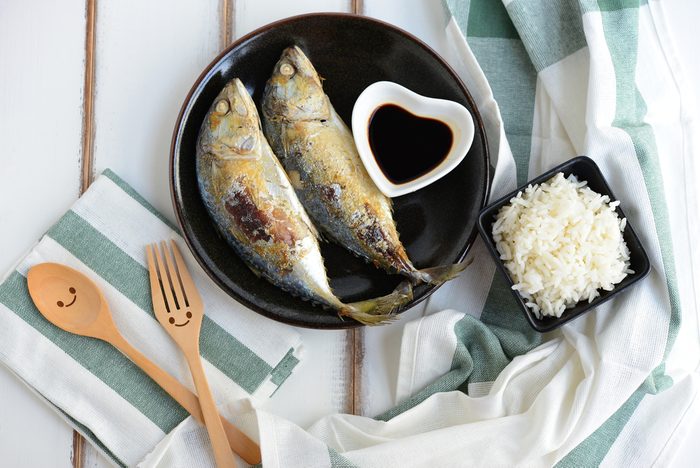
4. Atlantic mackerel
Usually sold as “round” (uncleaned whole fish); get your fishmonger to clean it.
How it Tastes: Some find this firm white fish has a too-strong flavour. (If that’s your take, why not follow Calder’s advice, below, and try it as an appetizer? You just might enjoy it.)
Nutritional Info: Perhaps the expression “holy mackerel” comes from this powerhouse’s omega-3 content-982 mg per 75-gram serving-or its vitamin B12 content (a serving has six times the RDA). If you opt for pickled or smoked mackerel, watch the sodium, which can be quite high. The contaminant risk is low, so there’s no reason to limit consumption.
Is It Eco-Friendly? This small-sized relative of tuna is a sustainable choice because it is so abundant. “Mackerel tend to school,” says MacKinnon, “so we can fish them with minimal impact on their habitat and other species.”
How to Serve It: “French cooks often poach mackerel fillets,” says Calder. “Use a little wine, water, a slice of onion and a few peppercorns.” Serve the poached mackerel on a baguette-the French like to serve it as a first course rather than as a main, she explains. Or, Calder suggests, you can make a quick spread by puréeing cooked mackerel in a food processor with a little butter and chopped fresh parsley, chives or dill; and red onion. Top it with lemon zest or lemon jelly. Serve with crackers.
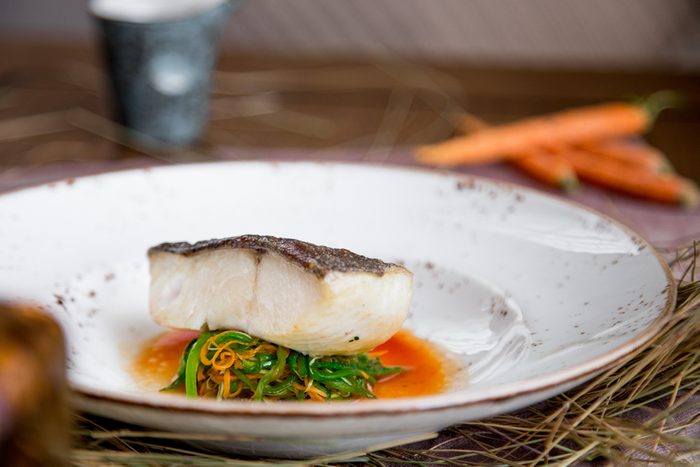
5.Atlantic mackerel
Also known as black cod.
How it Tastes: This mild white fish, with its large velvety flakes and sweet rich flavour, is popular among top chefs, and is sometimes called “butterfish” due to its buttery texture.
Nutritional Info: It is a great source of omega-3s, with 1,544 mg per 75-gram serving, and a good source of selenium (as are many fish). “Selenium is a trace mineral that may help protect cells from damage,” says Mary Sue Waisman, a registered dietitian in Fall River, N.S., and author of Flavour First. (To be cautious, women who may become pregnant, or are pregnant or breastfeeding should eat sablefish only once a week, to avoid exposure to relatively high levels of mercury.)
Is It Eco-Friendly? These are found throughout the North Pacific; conservation concern is low.
How to Serve It: Fillets are best pan-fried in a little oil, skin side down. Calder’s roasted red pepper sauce is a healthy way to dress it up: In a food processor, whiz up a few roasted red peppers with some sautéed onions deglazed with a splash of white wine. Add a few tablespoons of fish or chicken stock to desired consistency. Season with salt, pepper and lemon juice, and pour over fish.
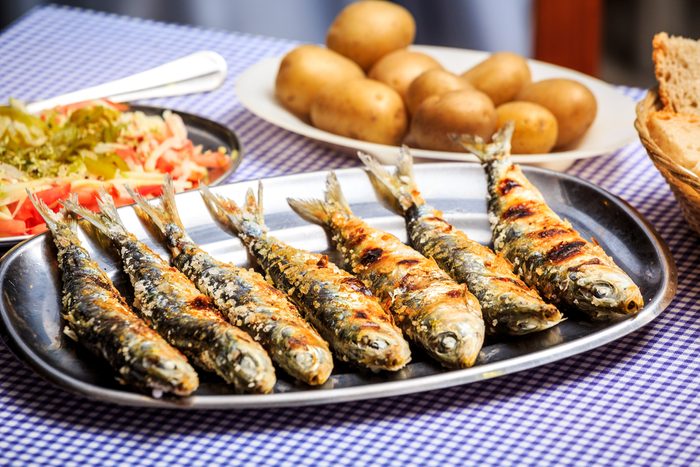
Other fish to try
Sardines, herring and anchovies are loaded with omega-3s, low in contaminants and eco-friendly, but many people don’t like their strong taste. (Fresh ones are less “fishy” than canned, which can also be high in sodium.) But sometimes, it’s just finding a great way to eat them. “I’m a tinned-sardine junkie,” says chef Laura Calder. “I’ll eat a sardine sandwich with mustard, or open a tin of kippers to eat with a mashed potato. It’s perfect food for one: fast, cheap and healthy.
Omega-3 content
- Pacific sardines, in tomato sauce, 106-g (4-oz) can: 1,546 mg
- Kippers (Atlantic herring, salted and smoked), 75-g (3-oz) serving: 1,668 mg
- Anchovies, 45-g (2-oz) can: 942 mg
